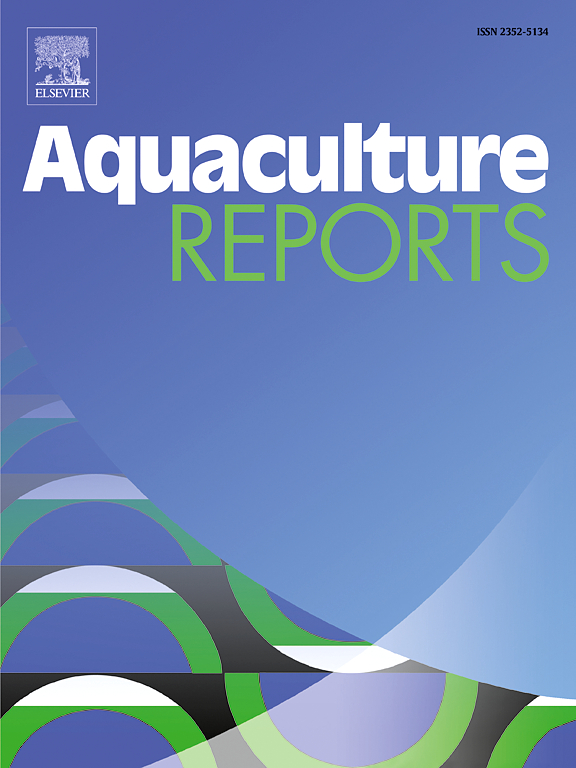更好地了解大马哈鱼(Cyclopterus lumpus)体内大马哈鱼虱(Lepeophtheirus salmonis)的排空时间
IF 3.2
2区 农林科学
Q1 FISHERIES
引用次数: 0
摘要
鲑鱼养殖场使用洁净鱼作为预防海虱侵扰的控制措施。近年来,圆头鱼(Cyclopterus lumpus)已成为挪威最常见的清洁鱼类。然而,很少有研究旨在量化块状鱼的清洁效果。有许多研究记录了肿块鱼胃内容物中海虱的数量。如果不知道斑鱼体内海虱的清除时间,这些数字就不能用来推断斑鱼的清洁效果。在这项研究中,我们旨在重复鲑虱(Lepeophtheirus salmonis)在块状鱼的疏散时间的实验。我们发现疏散时间的中位数为50 h,平均疏散时间为65 h。结合之前的实验数据,我们发现疏散时间的中位数为31 h,平均疏散时间为49 h。有趣的是,我们发现成年雌性鲑鱼虱的消化速度明显慢于其他活动鲑鱼虱。这意味着,如果块状鱼在不同阶段吃掉了相同数量的(绝对)虱子,那么人们就会期望胃内容物中有更多的成年雌性虱子,因为这些虱子需要更长的时间才能完全排出。本研究为进一步了解鲑鱼虱在肿块鱼体内的消化时间做出了重要贡献,最终可以结合肿块鱼胃内容物中鲑鱼虱的估计数量来估计清洁效果。本文章由计算机程序翻译,如有差异,请以英文原文为准。
Towards a better understanding of the evacuation time of salmon lice (Lepeophtheirus salmonis) in lumpfish (Cyclopterus lumpus)
Cleaner fish are utilised as a preventive control measure against sea lice infestations in salmon farms. In recent years, lumpfish (Cyclopterus lumpus) has been the most commonly deployed cleaner fish species in Norway. However, there have been few studies aiming to quantify the cleaning effect of lumpfish. There are many studies which document the number of sea lice in lumpfish stomach contents. These numbers cannot be used to infer the cleaning efficacy of lumpfish without also knowing the evacuation time of sea lice in lumpfish. In this study, we aimed to replicate an experiment of the evacuation time for salmon lice (Lepeophtheirus salmonis) in lumpfish. We found a median evacuation time of 50 h, and a mean evacuation time of 65 h. Combining with the data from the previous experiment, we found a median evacuation time of 31 h, and a mean evacuation time of 49 h. Interestingly, we found significantly slower digestion for adult female salmon lice than for other motile salmon lice. This implies that if lumpfish consumed the same (absolute) number of lice in different stages of lice, then one would expect more adult female lice in the stomach contents, as these require a longer time to be fully evacuated. This study is an important contribution to further understand the digestion time of salmon lice in lumpfish, which ultimately can be combined with an estimated number of salmon lice in the stomach contents of lumpfish to estimate a cleaning effect.
求助全文
通过发布文献求助,成功后即可免费获取论文全文。
去求助
来源期刊

Aquaculture Reports
Agricultural and Biological Sciences-Animal Science and Zoology
CiteScore
5.90
自引率
8.10%
发文量
469
审稿时长
77 days
期刊介绍:
Aquaculture Reports will publish original research papers and reviews documenting outstanding science with a regional context and focus, answering the need for high quality information on novel species, systems and regions in emerging areas of aquaculture research and development, such as integrated multi-trophic aquaculture, urban aquaculture, ornamental, unfed aquaculture, offshore aquaculture and others. Papers having industry research as priority and encompassing product development research or current industry practice are encouraged.
 求助内容:
求助内容: 应助结果提醒方式:
应助结果提醒方式:


